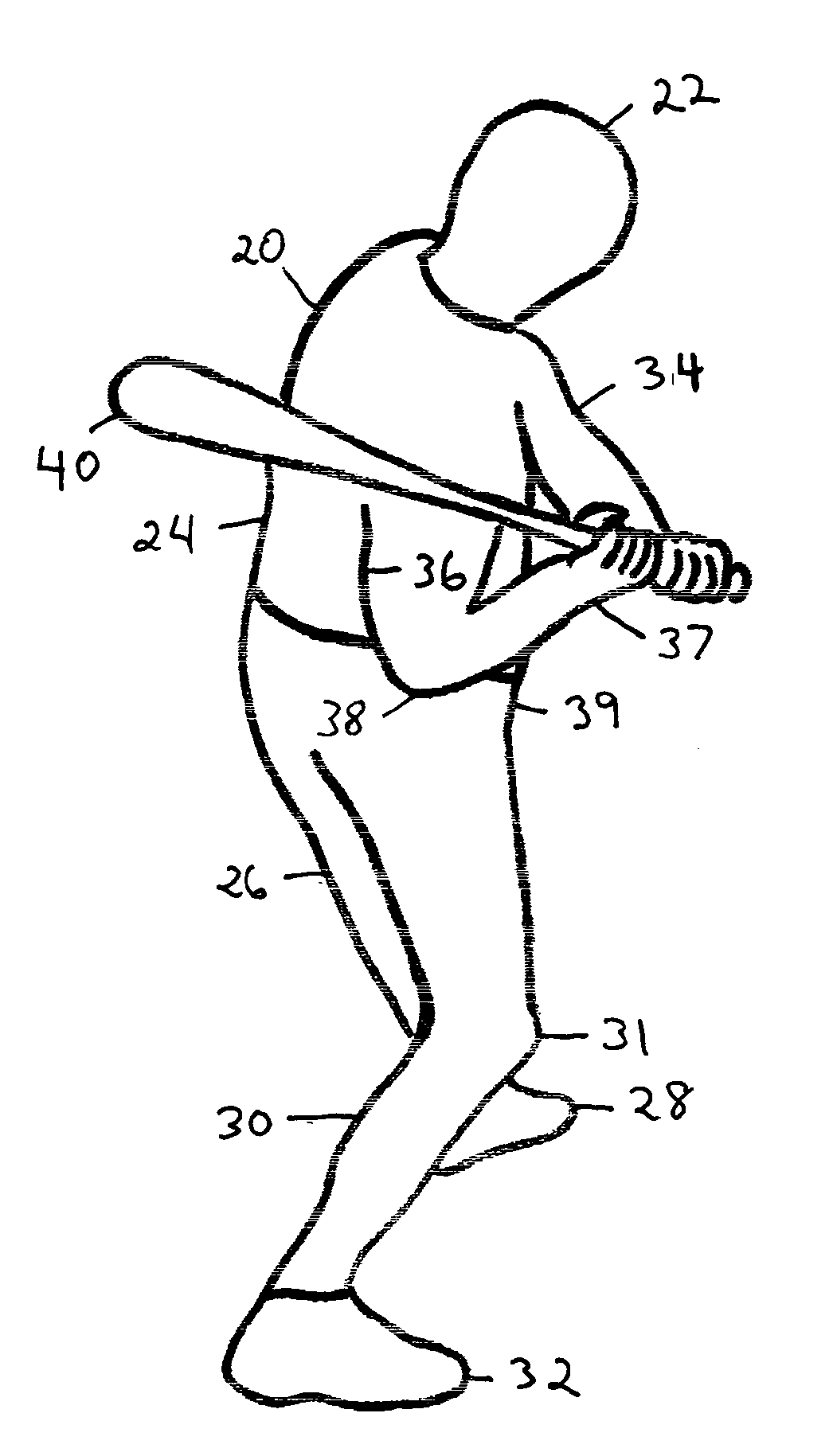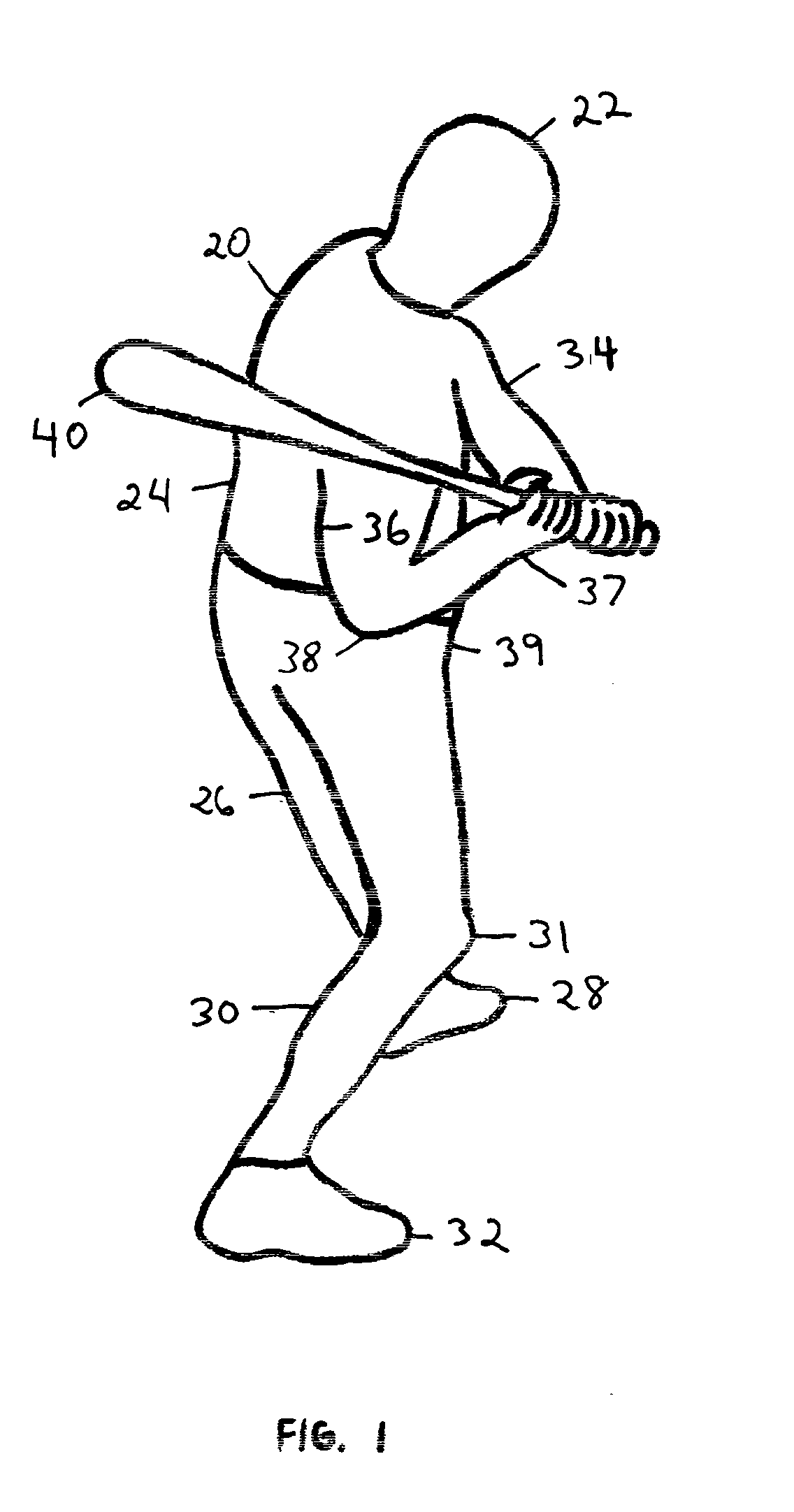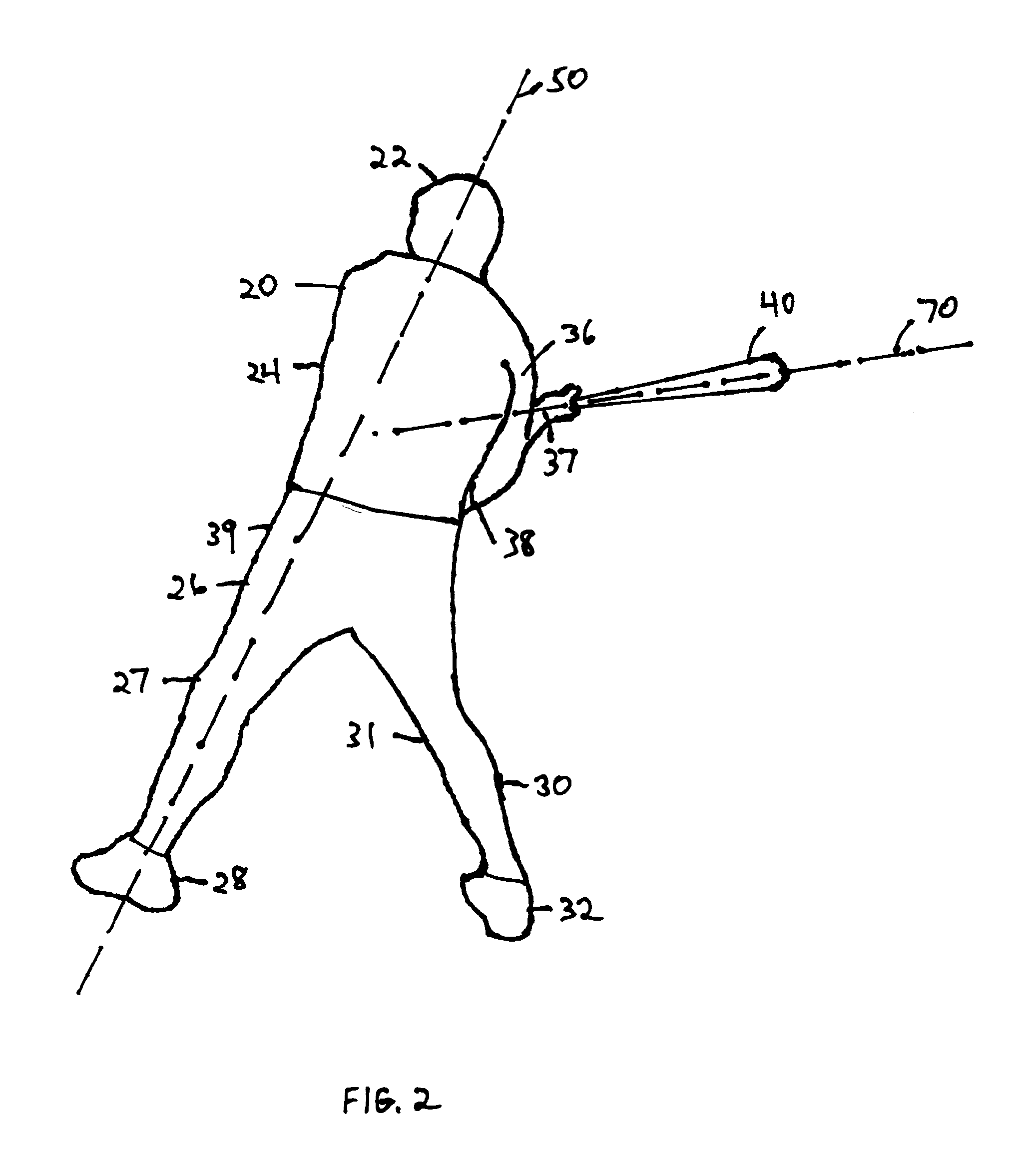[0013]This document discloses an improved methodology for a swing that is focused on accuracy without sacrificing power. In short it is referred to as a pivotal swing or a pivoting swing process. The pivotal swing methodology is directed to an improved delivery of a hitting device to a ball based on four main concepts or areas of improvement: (1) reduced head movement, (2) the hitting device starting and being delivered in the same plane of travel as the ball (hereinafter referred to as “Bat in Same Plane as Ball”), (3) better balance, and (4) simplification of the swing, which gives a hitter more time to observe the ball and decide what action to take. To accomplish these four main concepts or improvements, the hitter executes many elements that include five main positions or steps: 1) leading or front leg is stiff and straight at the start and during the swing until after contact with the ball is completed (hereinafter referred to as “Straight Front Leg”); 2) the leading or front foot is pointed at least partially in the direction from which the ball is traveling, and does not step or move forward (hereinafter referred to as “No Step”); 3) the hands and the bat are held lower than in conventional starting positions, such that the distal end of the bat is positioned below the shoulders, and the bat is held substantially parallel to the ground at the beginning of the swing (hereinafter referred to as “Low Horizontal Bat”); 4) the hitting device is delivered in the same plane as the ball is traveling, where the ball is typically traveling in a slightly downward plane and thus the hitting device or bat will be traveling in a slightly upward plane in the opposite direction of the plane of travel of the ball, and in other words, the bat moves directly forward (hereinafter referred to as “Bat Travels in Same Plane”); and 5) the swing utilizes a pivoting of the
trunk and hips about an axis, with no or little forward or
lateral movement of the body (hereinafter referred to as “Pivoting on the Axis”). The “axis” referred to here and throughout this application is the equivalent of a “pole” that goes down from above a batter in the ready position and down through the head, neck,
torso, entire front stiff and / or straight leg and foot and continuing into the ground. In this pivotal swing process, the body pivots about this axis or pole. It is a simplification that reduces or eliminates head movement and also creates better balance in the overall pivotal swing process. The terms element and step are used interchangeably throughout.
[0015]For a 0.300 hitter, a 50 to 100 point improvement is an increase of 16.6% to 33.3%. This increase in efficiency is astounding, not only in the field of baseball, but in many other disciplines. For example, increase in the yield of a
crop by 30% would result in a significantly greater supply of that
crop, and in all likelihood, significant
cost savings to the
consumer. The same is true for baseball. An increase of efficiency of 30% in batting average would result in more production for the baseball team. A baseball team would then win more games resulting in higher
ticket sales, higher revenues, and higher profits.
[0016]A little more explanation about the steps Low Horizontal Bat and Bat Travels in Same Plane may help create an understanding of how they contribute to the overall pivotal swing method. It is basically understood that the bat has to be in the plane of the ball in order for the ball to ever be hit. There is a huge difference in the bat eventually getting there after many elements of the conventional swing have been executed as compared to being in the same plane during the full pivotal swing process. There is also an
angle of incidence that is a major cause of reduced time available to make impact. In general, two objects (a bat and ball) that are traveling in different planes will only impact each other if they meet at the same time and point of the 2 intersecting planes at an
angle of incidence. However, two objects (for example: a pitched ball in the strike zone and a bat being delivered to that same strike zone) that are traveling in the same plane in opposite directions will essentially always impact each other. This is a huge issue that, if not understood, will seriously impact the understanding of how these two elements contribute to the pivotal swing process and how they are different from the current or conventional swing process. A key benefit is that the amount of
energy transfer will be higher when the ball and bat, traveling in opposite directions in the same plane, collide. Another benefit is that the pivotal swing process is simpler without the added steps needed to get the bat down from the prior art starting position of the conventional swing process to where the ball is. These two elements are useful to the overall results because they contribute to the noted improvements, including reduced head movement, better balance, and simplification of the swing, and are achieved in a unique way that has not been taught or disclosed in the past.
[0017]With the steps Low Horizontal Bat and Bat Travels in Same Plane more clearly understood, we can now expand on how they impact the simplification of the overall pivotal swing process. With the Low Horizontal Bat, the bat only needs to be brought directly forward in the plane of the ball. This simplification allows more time to ascertain the direction and spin of the ball and allows the pivotal swing process to deliver the bat directly to the ball with reduced head movement and maintaining better balance.
[0018]It is important to note how the steps described above contribute to the improvements of the current invention and how these elements also contribute to unexpected and useful results. However, to
list each element individually with all its contributions to each improvement as well as the various combinations of them and their contributions to individual and combinations of improvements would be overly redundant and repetitive. Instead, examples will be provided as representations of all the individual and combined results. One such example was discussed above while explaining some of the special aspects of how the two elements Low Horizontal Bat and Bat Travels in Same Plane contributed to three improvements: simplification of the swing, reduced head movement, and better balance. It should be reasonably clear that either one of those two steps by themselves will contribute to one or more of the improvements. However, the amount of improvement is significantly increased when multiple steps disclosed herein are combined and synergistic benefits are obtained.
[0019]An additional example of how the various elements both individually and in combination contribute to improvements or combinations of improvements includes the steps Straight Front Leg, No Step, and Pivoting on the Axis. Each of these contributes individually to all previously mentioned improvements; however, when they are combined, they produce even higher levels of improvement when compared to each step individually. The Straight Front Leg is a key part of creating the axis upon which to pivot; it builds a firm foundation for better balance. When we add the No Step element, we are maintaining the creation of the axis and maintaining the firm foundation. In addition, it contributes to the simplification of the swing. Upon adding the Pivoting on the Axis step, we continue to maintain the axis and firm foundation while all three steps are contributing to better balance. They are also continuing to add to the simplification of the swing, which is providing synergistic benefits of enhancing the improvements. The first two elements, Straight Front Leg and No Step, are also a key part of achieving the improvement of reduced head movement. The design of the pivotal swing process then was able to add the element of Pivoting on the Axis to create the necessary power in the swing while maintaining the improvements already in place for better balance, reduced head movement, and simplification of the swing. These three steps are all synergistically contributing to those three improvements, which in turn allow the hitter to more precisely deliver the hitting device to the specific location of the ball.
 Login to View More
Login to View More  Login to View More
Login to View More 


